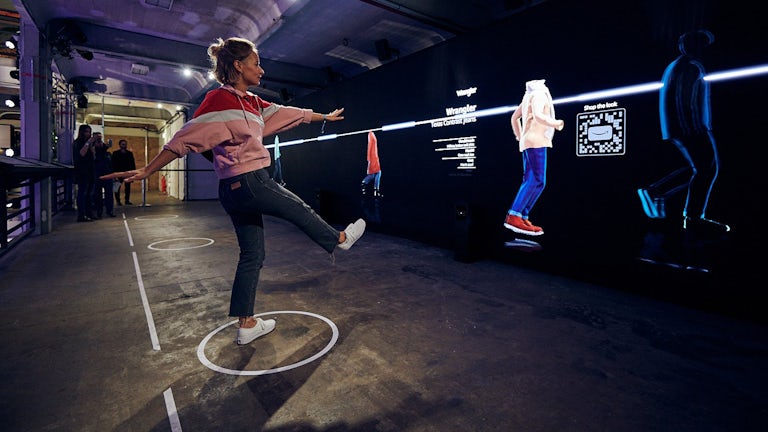Shopping Bag (0)
Shopping bag is empty

From high concept to high street and from online to D2C, 2020 has expedited drastic changes in the sector.
It was already a challenging time for retail pre-pandemic. Whether through choice or necessity, the past 12-plus months have pushed brands to be creatively brave, innovate and create rich yet seamless, omnichannel retail experiences – and it's clearly not one size fits all.
Starved of experience for over a year, the potential for true retail experiences as destinations has never been stronger: hubs where people, brands and culture come together. But to be successful, brands need to take into account the entire customer journey: before, during and after – to both lean into the richness and tangibility of the physical as well as the efficiency of the digital. It's time to reboot the retail experience.
In a move that's caught both industry and consumer attention alike, there's been great interest in the launch of Amazon's London tech-enabled salon, which lets customers see potential styles via AR and find out more about the latest products by simply pointing at them (a screen then brings up brand videos and educational content).
This innovation shouldn't come as a surprise. Despite "owning the internet", the tech giants continue to see the importance of turning up at retail in interesting ways, highlighting how only physical can deliver or enhance certain experiences.
Brands like Amazon and Google are known for their efficiency at getting best value or the speed of sourcing information, but as they have moved into new areas and product, they've also proven themselves to be innovators, adding real value to the consumer experience.
Google's "Curiosity rooms" recognised the importance of audiences getting hands-on with the product, albeit through a series of editorial, immersive and shareable windows and experiences at a five-week destination store in London.
Likewise Amazon's "Destination denim" outshone many concept stores but used proprietary technology to create a digital catwalk and an Alexa-enabled experience to help audiences find their perfect pair from more than 2,000 pairs on Amazon online.
And as retail reopens in some territories, high-impact flagships are launching as places for brands to show their depth and build stronger bonds with their communities.
Hot on the heels of its London flagship store, Adidas launched both its most sustainable and technologically advanced store in Dubai Mall, combining the immersive nuances of RFID fitting rooms, while appealing to sneakerheads' affection for products like Crep Protect, which has its own permanent space within the store.
The philosophy of using your phone as a remote control for the store is apparent. The physical retail environment enables brands to start conversations with their audiences while their mobiles enable them to carry it on.
The Anya Hindmarch village is an arresting idea – taking a well-heeled street in London and creating spaces to experience the brand in a holistic way – from a cafe to a "Plastic Shop" that celebrates the designer's long-term interest in the circular economy. There's even a village hall. It's ideas like these that show the power of thought from a true creative director's perspective.
Meanwhile continuing to cash in on the much loved franchise, the world's largest Harry Potter store, set to open in NYC this June, will be curated as mini visitor attraction in its own right, with 15 themed areas including a MinaLima gallery of graphic art, an interactive wand table and two multi-player VR games.
In contrast, premium car marques are moving a little closer to the audience and into the shopping mall experience with Polestar's "Spaces", already at Westfield, continuing to be being rolled out in the US. People no longer want to visit showrooms on the outskirts of town – they want the automotive experience as part of a day out.
Streetwear brand Kith has opened its first European store in Paris, inside an old mansion, housing a cafe, various art installations and a basement fitted out like an aircraft cabin. You can't take such flights of fancy via your screen.
In a similarly grand vein, London fashion establishment Browns has unveiled its new home in a Grade II listed building. The ground floor zero-waste restaurant is the thing that sets it apart physically, but the overlaid tech from its sibling Farfetch is what will likely help it gauge the success of the venture, potentially helping to track when someone has visited for a drink and purchased an item online afterwards.
Leading from the front Dr. Martens has proven that "doing good" and being commercially successful don't need to be mutually exclusive. Despite more than 100 stores being closed, they still doubled down on their commitment to more than 15 creative communities when they need it most and still saw sales rise by nearly 50% and group profits almost doubling.
And whether it's Nike's Refurbished programme, rolled out at 15 of its US stores, taking barely worn shoes and offering them for resale, H&M with its free 24-hour suit hire scheme, or Asda announcing it will sell second-hand clothing, the sustainable buying habits of Gen Z are having an impact on the wider market.
With initiatives like these, we are nudged into more responsible behaviours, and for the all-important incoming generation of consumers, the lure of circularity will keep them coming back to certain brands.
Click to find out more about Amazon Destination Denim, Google Curiosity Rooms and adidas Ultraboost 20.
Adam Thompson is strategy director (retail) and Jonathan Emmins is founder at Amplify.
To read the full article visit Campaign.